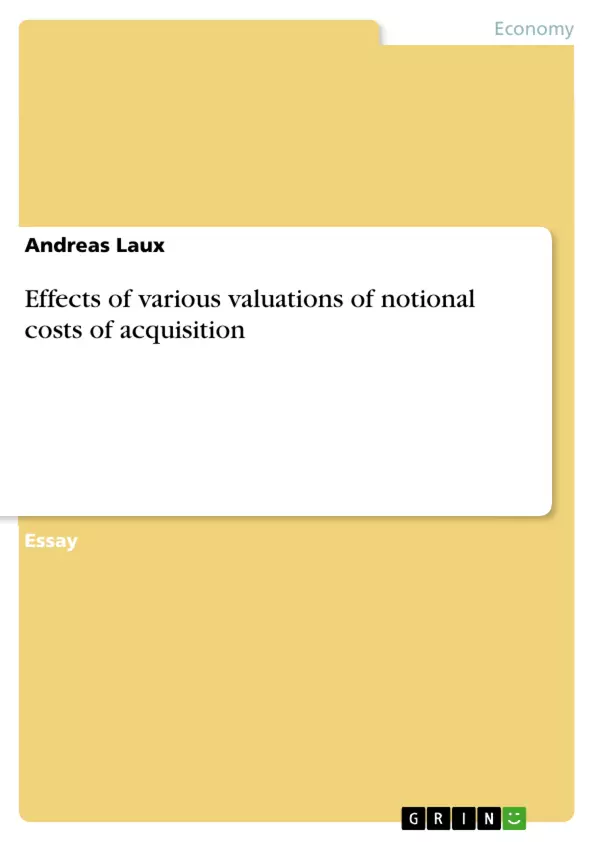The current economic crisis shows that the valuation of assets is an important subject for our global economy because reserves help a company to better withstand a crisis. The valuation of assets should therefore be perfected as soon as a company is established. How non-cash contributions are valued in the start-up balance sheet has long-term consequences for future balance sheets and profit and loss accounts.
There is a loophole in the valuation of non-cash contributions in Germany as the §§ 242 I, 253 I, 255 I HGB (German Commercial Code) are only to be applied by analogy. When comparing this with international standards on the other hand, the valuation of non-cash contributions on company start-up is clearly regulated in other countries; for example in Austria by codification of the fair value in § 202 UGB (Austrian Commercial Code) and in the IFRS reporting system by the principle of fair value. Due to the German loophole, there is an ongoing controversial discussion in academic literature on the valuation of non-cash contributions. This leads to a need to investigate the effects of various valuations of notional costs of acquisition in more detail by using case studies with the aim of ascertaining whether there should be a uniform perspective and accordingly an ideal valuation.
Inhaltsverzeichnis (Table of Contents)
- 1 INTRODUCTION
- 2 BASE CASE
- 3 CRITERIA TO JUDGE CASE STUDIES.
- 4 CASE STUDY 1: FAIR VALUE AS NOTIONAL ACQUISITION COSTS
- 5 CASE STUDY 2: HISTORICAL ACQUISITION COSTS AS NOTIONAL ACQUISITION COSTS
- 6 CASE STUDY 3: GOING-CONCERN VALUE AS NOTIONAL ACQUISITION COSTS...
- 7 CASE STUDY 4: BOOK VALUE AS NOTIONAL ACQUISITION COSTS.
- 8 CASE STUDY 5: FACE VALUE AS NOTIONAL ACQUISITION COSTS
- 9 SUMMARY OF THE RESULTS OF THE CASE STUDIES.
Zielsetzung und Themenschwerpunkte (Objectives and Key Themes)
This work investigates the effects of various valuations of notional costs of acquisition by using case studies. The aim is to analyze whether there should be a uniform perspective and consequently an ideal valuation for non-cash contributions in company start-ups.
- Valuation of non-cash contributions in start-up balance sheets
- Effects of different valuation methods on future balance sheets and profit and loss accounts
- Comparison of German and international standards on non-cash contribution valuation
- Analysis of the impact of various valuation methods on financial reporting
- Determination of an ideal valuation approach for non-cash contributions
Zusammenfassung der Kapitel (Chapter Summaries)
- Introduction: This chapter provides an overview of the importance of asset valuation in the current economic crisis. It highlights the need for a consistent approach to valuing non-cash contributions in start-up balance sheets, especially considering the differences in German and international regulations.
- Base Case: This chapter establishes a base case scenario for the valuation of a non-cash contribution, including the different valuation methods: fair value, historical acquisition costs, going-concern value, book value, and face value. It defines each valuation method and its significance in the context of start-up balance sheets.
- Criteria to Judge Case Studies: This chapter outlines key criteria to be used in the evaluation of the effects of different notional acquisition costs. These criteria include avoiding hidden reserves, objectification of valuation, practical efforts for the founder, share capital impact, information content for external users, and compliance with the creditor protection principle.
- Case Study 1: Fair Value as Notional Acquisition Costs: This chapter analyzes the effects of using fair value as the basis for valuation. It examines the advantages and disadvantages of this method in terms of the established criteria.
- Case Study 2: Historical Acquisition Costs as Notional Acquisition Costs: This chapter investigates the impact of using historical acquisition costs for valuation. It evaluates the method based on the criteria outlined earlier.
- Case Study 3: Going-Concern Value as Notional Acquisition Costs: This chapter examines the use of going-concern value as the basis for valuation. It discusses the implications of this method with respect to the defined criteria.
- Case Study 4: Book Value as Notional Acquisition Costs: This chapter analyzes the effects of using book value for valuation. It evaluates the method based on the criteria outlined earlier.
- Case Study 5: Face Value as Notional Acquisition Costs: This chapter explores the use of face value as the basis for valuation. It examines the implications of this method with respect to the defined criteria.
Schlüsselwörter (Keywords)
This work focuses on the valuation of non-cash contributions in start-up balance sheets, particularly examining different valuation methods such as fair value, historical acquisition costs, going-concern value, book value, and face value. The study also analyzes the impact of these valuations on financial reporting, creditor protection, and the overall information content for external users. Key concepts include the German Commercial Code (HGB), IFRS, creditor protection principle, and the impact of different valuation methods on financial statements.
- Quote paper
- Andreas Laux (Author), 2014, Effects of various valuations of notional costs of acquisition, Munich, GRIN Verlag, https://www.grin.com/document/276355



